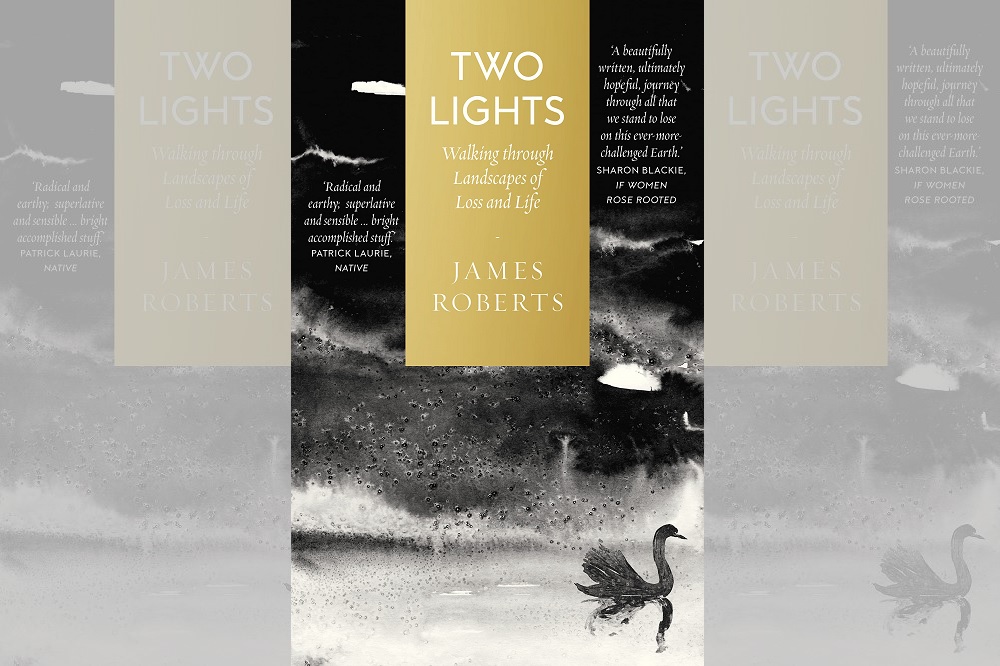Review: Two Lights – Walking through Landscapes of Loss and Life by James Roberts

Gaynor Funnell
‘Who speaks for wolf, for bear, for fox, for gull, for heron, for kingfisher – for all species, not just our own?’
In this lyrical and moving book, James Roberts weaves close observation of nature and place intertwined with memoir and science, with a heart-felt analysis of the predicament facing the natural world, the world we are continuing to destroy. He write of a lived experience, past and present, with an eye towards the future.
Travelling alongside him, we move from his home in Wales, to the Congo, Kenya, Canada, and back again, through deep time and into space, walking both through the physical landscape, and his personal landscape of life and loss.
Roberts shows us this world through the lens of dawn and dusk, the two lights which mark the beginning and the end of each day. Starting at dawn, we follow this light, travelling through Russia, Mongolia, Indonesia, the Alps, flying with crested auklets, puffins, golden eagles, Arctic terns and stilts, until we arrive at his home in Wales, where ‘…the last stars are fading out of an indigo sky. On the horizon is a band of burnt orange graduating to turquoise. Strand of cloud hang like tail feathers.’
A theatre of birdsong
Here, the blackbirds start the dawn chorus until ‘The world is a theatre of birdsong’. But amongst the beauty, he is very aware that ‘Every time the wave of light crosses Earth, more of the wild has been lost.’ And this is a theme running throughout the book. As he walks through the landscape near to his home, a landscape he knows intimately well, he is reminded of all the animals and birds that have been erased from this place, and mourns those we are losing.
Roberts has a deft way of linking wildlife, memoir and research together, like stepping stones leading the reader onwards. It’s as if he’s had a train of thought whilst out walking and follows it to see where it takes him. In the chapter entitled ‘The Lion, The Wolf and The Curlew’, he moves from the wonder of hearing and seeing lions in Africa, to discussing barbary lions skulls discovered in the moat of the Tower of London, to cave lions that once inhabited the British Isles.
Drawings of lions in caves, lead onto a picture of a wolf in a book that scared him as a child. Wolves also roamed the hills of Wales, until hunted to extinction. Roberts once saw a wolf in Canada, of which he says ‘That experience was one of the most visceral of my life, an interspecies close encounter, a one-to-one with the wild.’ Alongside the books dedication to his wife Julia, is a dedication to the wolf.
Crisis
Not just in the title of this chapter, but appearing and calling their unique, sorrowful call throughout the book, is the curlew, which becomes, to him, a symbol of the extinction crisis.
During lockdown they appear more, almost as if the landscape has been returned to them. He sees them once, rising across the hill against a rainbow background. And as their behaviour is unusual, he wonders if he saw them at all.
‘This could be my imagination at work, projecting them on to this emptied place where centuries ago wolves hunted and, before them, lions. We are all, at the last, just fading shapes in the memories of others.’
Discussing personal grief and anxiety is something that Roberts doesn’t shy away from. As a child, he suffered from anxiety and hypersensitivity, emotions he continues to feel now. He compares his depression to the weather.
‘It contains climates, weathers. It can be tropical or temporal. You can burn or freeze, be soaked to the skin, blown sideways.’
Bittersweet
The loss of his father, the illness of his wife, alongside the grief he feels at the loss of the natural world, permeates his writing, even when he’s not talking about them directly. There’s a bittersweet quality running alongside his at times poetic prose. And at the end, there’s an almost acceptance of his depression.
‘Perhaps I should not see depression as an illness but as a symptom of the damage which reaches across the species barrier, into the hills, the rivers, every tributary and stream.’
As we started at dawn, we finish at dusk, the time of day which Roberts loves the most. He offers us snapshots of landscapes and the life held within them, some beautiful, some not so. But wonder of the world is still present. And again, the birds are everywhere. We fly with egret, buzzard, raven and gannet as the light fades until there are no colours.
Shape-shifting
The simplicity of the black and white accompanying drawings and cover add a stunning, visual layer to Roberts narrative. He uses only ink, water and salt to create these shape-shifting images, the simplest method he could find.
This is a book of quiet beauty, something to be savoured slowly, without rush. Maybe to be read at dawn, or at dusk. I loved it.
Two Lights: Walking through the Landscapes of Loss and Life by James Roberts is published by September Publishing. It’s available here or from any good bookshop.
Support our Nation today
For the price of a cup of coffee a month you can help us create an independent, not-for-profit, national news service for the people of Wales, by the people of Wales.






